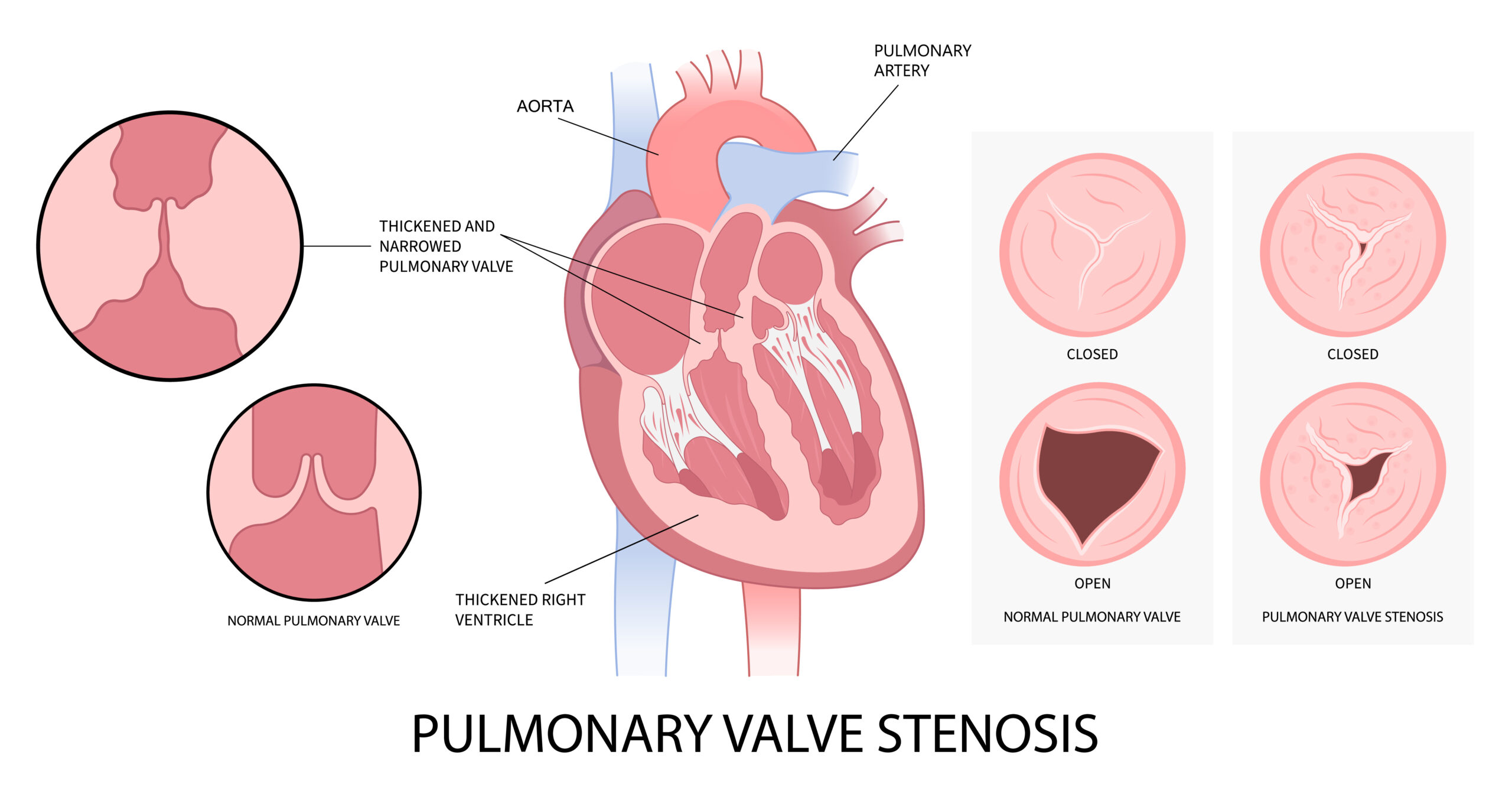Causes And Treatment Of Pulmonary Stenosis
Lorem ipsum dolor sit amet, consectetur adipiscing elit.

Causes And Treatment Of Pulmonary Stenosis
Pulmonary stenosis is a heart condition in which the pulmonary valve, which controls blood flow from the heart to the lungs, becomes narrow or blocked. This can make it difficult for blood to flow properly through the heart, leading to various symptoms and complications.
You may have heard of heart valve problems. Pulmonary stenosis, a condition affecting the pulmonary valve, can impact your heart’s ability to pump blood effectively to your lungs. If you’re experiencing shortness of breath, fatigue during exercise, or have a family history of heart valve issues, consider visiting our Atlanta heart doctors for testing.
Pulmonary stenosis occurs when the pulmonary valve, which controls blood flow from your heart to your lungs, becomes narrowed or obstructed. Think of this valve as a gateway—when it’s narrowed, it’s like trying to push the same amount of traffic through a smaller opening. This narrowing forces your heart to work harder to pump blood to your lungs, potentially leading to complications.
You might wonder why pulmonary stenosis is a concern, especially if you haven’t noticed any significant symptoms. This condition can range from mild to severe; even mild cases can progress over time. In severe cases, the extra strain on your heart can lead to right ventricular hypertrophy (enlargement of the right side of your heart) or even heart failure. People with pulmonary stenosis may be at higher risk for heart rhythm abnormalities.
Symptoms of pulmonary stenosis can vary widely. In mild cases, you might not notice any symptoms. As the condition progresses, you may experience shortness of breath, especially during physical activity. Some people report fatigue, chest pain, or a rapid, fluttering heartbeat. Poor weight gain or fatigue during feeding might be signs of pulmonary stenosis in infants and children.
By visiting our Atlanta heart doctors, you’re taking a proactive step toward managing this condition. Our cardiologists are experts in diagnosing and treating pulmonary stenosis. They can perform specialized tests like echocardiograms or cardiac catheterization to assess the severity of the stenosis and its impact on your heart function.
During your visit, you’ll receive personalized testing and treatment. Our doctors will evaluate the severity of your pulmonary stenosis and its effect on your overall health. They’ll work with you to develop a comprehensive management plan, which might involve regular monitoring for mild cases, medications to ease symptoms, or, in more severe cases, procedures to repair or replace the pulmonary valve.
Don’t let pulmonary stenosis go unchecked. Schedule an appointment with our Atlanta heart doctors today to ensure you receive the best possible care. While pulmonary stenosis can be a serious condition, many people with this valve problem lead full, active lives with proper management. Our team is here to support you at every stage, from diagnosis through long-term care, helping you maintain optimal heart function and quality of life despite this heart valve condition.
Read on for more information on pulmonary stenosis testing and treatment and how CVG provides comprehensive cardiac care.
Risk Factors for Pulmonary Stenosis
Several risk factors can increase a person’s likelihood of developing pulmonary stenosis. These include:
- Congenital heart defects: Pulmonary stenosis is often present at birth due to abnormalities in the development of the heart.
- Family history: A family history of heart defects or conditions that can lead to pulmonary stenosis, such as rheumatic fever, may increase the risk of developing the condition.
- Infections: Certain infections, such as streptococcal infections, can damage the heart valves and increase the risk of pulmonary stenosis.
- Chronic illnesses: Conditions such as lupus or rheumatoid arthritis, which can cause inflammation in the body, may increase the risk of pulmonary stenosis.
- Age: The risk of developing pulmonary stenosis increases as the heart valves may become damaged or weakened over time.
- Gender: Pulmonary stenosis is more common in males than females.
- Lifestyle factors: Factors such as tobacco use, unhealthy diet, and a sedentary lifestyle can increase the risk of developing pulmonary stenosis and other heart conditions.
Not all risk factors can be controlled, but making healthy lifestyle choices and receiving regular medical care can help reduce the risk of developing pulmonary stenosis and other heart conditions. Suppose you have a family history of heart conditions or are at increased risk of developing pulmonary stenosis. In that case, discussing your risks with your doctor and taking steps to manage your heart health is important.
Causes of Pulmonary Stenosis
There are several possible causes of pulmonary stenosis, including:
- Congenital heart defects: Pulmonary stenosis can occur at birth due to abnormalities in the heart’s development.
- Rheumatic fever: This condition, caused by a streptococcal infection, can damage the heart valves and lead to pulmonary stenosis.
- Scarring or inflammation of the pulmonary valve: Certain conditions, such as endocarditis (an infection of the inner lining of the heart) or lupus, can cause scarring or inflammation of the pulmonary valve, leading to stenosis.
Testing for Pulmonary Stenosis
Pulmonary stenosis is usually diagnosed through a physical examination and a range of tests, including:
- Echocardiogram: This test uses sound waves to create a detailed image of the heart, allowing doctors to see the size and shape of the pulmonary valve.
- Cardiac catheterization: This test involves inserting a thin tube into a blood vessel and guiding it to the heart, allowing doctors to measure the pressure and blood flow through the pulmonary valve.
- Chest X-ray: This test can show the heart’s size and shape and any abnormalities in the pulmonary valve.
Treatment for Pulmonary Stenosis
Treatment for pulmonary stenosis depends on the severity of the condition and the presence of any other heart conditions. Mild cases may not require treatment, while more severe cases may need medications or surgery to widen or repair the pulmonary valve. In some cases, a heart catheterization procedure using a balloon catheter may be used to widen the valve. Surgery may be necessary to repair or replace the pulmonary valve in more severe cases.
There are several surgical options for treating pulmonary stenosis, including:
- Valvulotomy: This procedure involves making an incision in the pulmonary valve to widen it and improve blood flow.
- Valvuloplasty: In this procedure, a balloon catheter is used to widen the pulmonary valve from the inside.
- Valve replacement: In cases of severe stenosis or damage to the pulmonary valve, replacing the valve with a mechanical or biological valve may be necessary.
After surgery, patients will typically need to follow a period of rest and recovery and may need to take medications to prevent infection and blood clots. In some cases, further treatment may be necessary to address any underlying conditions that may have contributed to the development of pulmonary stenosis.
In summary, pulmonary stenosis is a heart condition where the valve narrows or blocks, making it difficult to pump blood through the heart. Congenital heart defects, rheumatic fever, or scarring or inflammation of the pulmonary valve can cause it. Symptoms may include shortness of breath, chest pain, rapid or irregular heartbeat, and bluish skin color.
Diagnosis typically involves a physical examination and a range of tests, and treatment may include medications, heart catheterization, or surgery to repair or replace the pulmonary valve. Several surgical options, including valvulotomy, valvuloplasty, and valve replacement, are available for treating pulmonary stenosis.
After surgery, patients will typically need to follow a period of rest and recovery and may need to take medications to prevent infection and blood clots. In some cases, further treatment may be necessary to address any underlying conditions that may have contributed to the development of pulmonary stenosis.
Symptoms of Pulmonary Stenosis
Symptoms of pulmonary stenosis can vary depending on the severity of the condition. Mild cases may not cause any symptoms, while more severe cases can cause symptoms such as:
- Shortness of breath: This can occur during physical activity or at rest and may be more severe in cases of severe pulmonary stenosis.
- Chest pain: This may be caused by the strain on the heart due to the narrowed pulmonary valve.
- Rapid or irregular heartbeat: The heart may have to work harder to pump blood through the narrowed valve, leading to an irregular rhythm.
- Bluish skin color: This can indicate low oxygen levels in the blood due to difficulty pumping blood through the lungs.
Why Choose CVG?
Related Conditions:
- Causes And Treatment For Heart Arrhythmia
- Causes And Treatment Of Pulmonary Stenosis
- Expert Insights on Cardiac Catheterization
- Expert Insights on Low Blood Pressure
- Exploring the Latest Advances in Atrial Fibrillation Treatment
- Dangerously high cholesterol?
- Get Your Blood Pressure Test Today!
- Understanding Electrical Cardioversion
- What Are ACE Inhibitors Used For?
- What foods are high in cholesterol?
- What Heart Flutters Can Mean
- What is Heart Failure & How to Treat it?
- What Is The Success Rate Of The Watchman Procedure?
Top Conditions:
- How long can someone live with an enlarged heart?
- Pros and Cons of the Watchman Device
- Risks and Complications of Cardiac Catheterization
- Side Effects Of The Watchman Device
- The Benefits of Cardiac Catheterization
- The Dangers Of High Blood Pressure
- The Dangers Of High Cholesterol
- The Watchman Implant Procedure
- Tips To Lower High Cholesterol
- Understanding Cardiac Catheterization
Call to Schedule an Appointment
Board-certified Doctors
CVG’s twenty board-certified heart doctors will guide you through your healthcare journey with the utmost compassion and individual attention. We aim to provide you with state-of-the-art cardiac care that includes the full spectrum of services, from testing to diagnosis and treatment. The doctor/patient relationship is built on trust. Through our combined efforts, we can conquer any challenge that comes our way.
Invasive therapies may also treat an abnormal heart rhythm, such as electrical cardioversion, which sends electrical impulses through your chest wall and allows normal heart rhythm to restart, or catheter ablation that disconnects the abnormal rhythm’s pathway. Suppose your doctor determines that electrical devices are the best course of action. In that case, you may be given a permanent pacemaker, an implantable cardioverter-defibrillator (ICD), or biventricular (B-V) pacemakers and defibrillators.
How CVG Can Help
CVG offers multiple services that can discover an enlarged heart or conditions that will lead to it. At CVG, we perform stress tests that will observe blood flow and test for various forms of heart disease. There are three types of stress tests that we perform:
- A treadmill test is a test in which you will walk on a treadmill that gets faster and steeper every 3 minutes. This will stress your heart so that our nurse or doctor can determine your heart rate and blood pressure.
- An echo test is performed before and after your treadmill test to determine how well your heart pumps blood.
- A nuclear stress test is a treadmill test that is prefaced by an injection of medicine that shows the flow of blood to your heart.
We also offer cardiac catheterization to diagnose and treat several heart issues. If any of these tests determine a problem, we offer treatment solutions such as atrial fibrillation testing and catheter ablation. Learn more about our services here, or schedule an appointment to talk to our doctors.
Schedule Your Appointment with a CVG Atlanta Area Cardiologist
Expertise, experience, and compassion are the pillars of CVG’s patient-centered cardiac care. Please schedule your appointment with CVG today. Call (770) 962-0399 or 678-582-8586. You may also request an appointment online. If you have an emergency, don’t contact us online; please call 911.
Locations That Treat Pulmonary Stenosis













